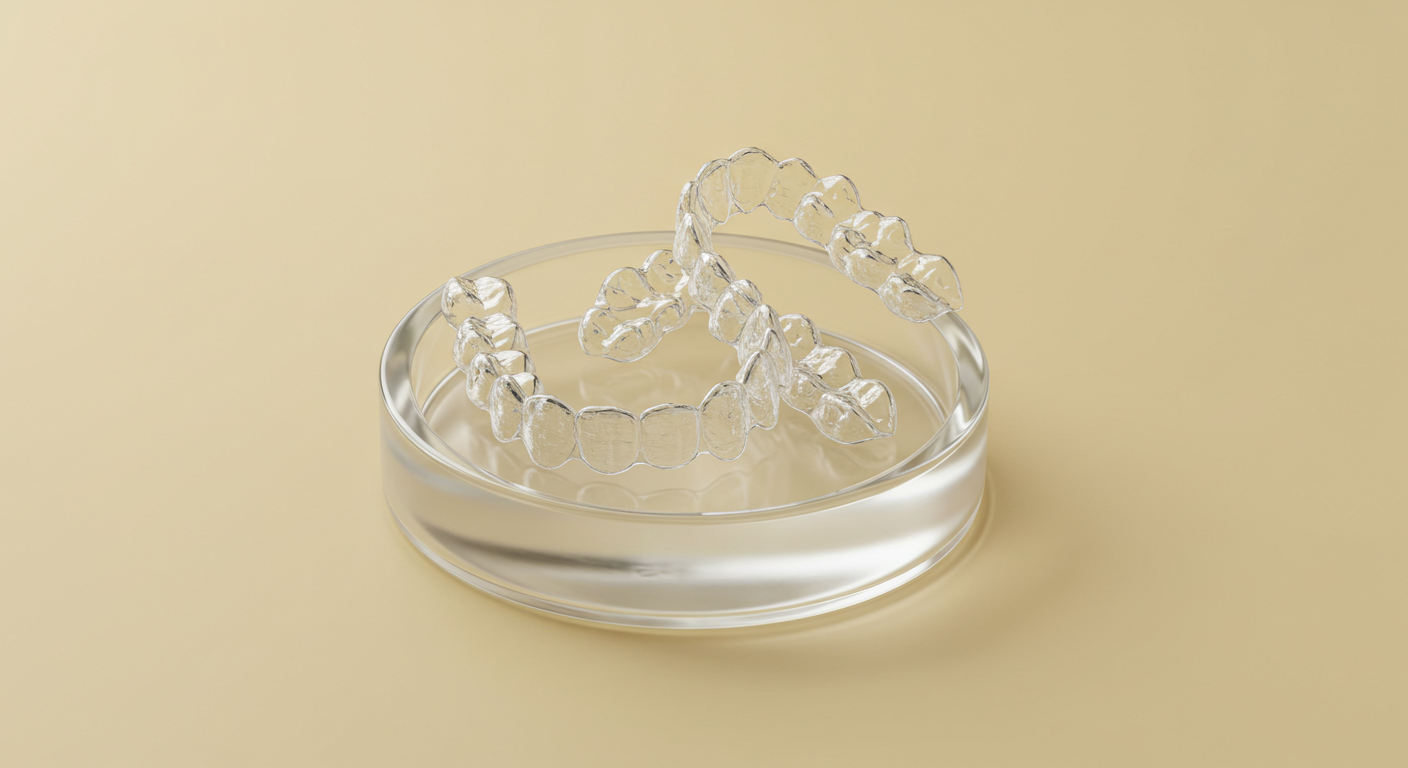Contents

What Are the Disadvantages or Dangers of a Dental Tray? Everything to Know Before Starting
For several years, the dental tray has become a popular solution to replace traditional metal orthodontic appliances, thanks to its discretion and comfort. However, while it offers many advantages, it also has limitations that are essential to understand. Before you begin, consult a dentist to assess if this treatment is right for you. In this article, we guide you through the pros, cons, and effectiveness of dental trays for an informed decision.
Discover why a dental tray is an attractive option, but also the challenges it may pose for your oral health.
What Is a Dental Tray?
A dental tray is a removable appliance, custom-made from a patient's dental impressions. It fits perfectly over your teeth to treat various oral issues, such as:
- Teeth alignment (malocclusions).
- Bruxism (teeth grinding).
- Teeth whitening.
- Cavity prevention through fluoridation.
Its main convenience lies in its removability: you can take it out to eat, drink, or brush your teeth, and it's easy to maintain with regular cleaning.
What Are the Advantages of a Dental Tray?
The dental tray is particularly appreciated for its discretion, thanks to its transparency, which makes it ideal for patients concerned about their appearance. Here are its main benefits:
- Quick Effectiveness: It can straighten teeth or treat bruxism in just a few months, compared to several years for traditional metal braces.
- Optimal Comfort: Custom-made, it fits your dentition perfectly, offering comfortable daily wear.
- Minimal Pressure: Unlike fixed appliances, it exerts a light and continuous, generally painless pressure to reposition teeth or protect enamel.
- Flexibility: Being removable allows you to take it out to eat, speak, or engage in activities, while facilitating maintenance with a simple cleaning after each meal to prevent plaque buildup.
- Aesthetics: Its transparent appearance makes it almost invisible, perfect for adults or teenagers sensitive to aesthetics.
What Are the Disadvantages of a Dental Tray?
Despite its many advantages, the dental tray has some drawbacks that are important to consider:
- Risk of Stains: Certain foods or drinks like coffee, tea, or soda can stain the tray, altering its translucent appearance. While you don't need to drastically change your diet, frequent cleaning is essential.
- Inconvenience at Mealtimes: The need to remove the tray before every meal can become burdensome, especially for frequent snackers. This can discourage some patients or complicate their routine.
- Temporary Lisp: Initially, the tray may cause a slight lisp or change in speech. Don't worry, this usually disappears after an adjustment period as your mouth gets used to the appliance.
- Dependence on Follow-up: If the treatment is not followed rigorously (regular wear, visits to the dentist), the results can be limited or nonexistent. It is crucial to follow recommendations—often 20 to 22 hours of wear per day for orthodontic trays—and maintain regular check-ups.
- Cost and Accessibility: Although discreet, a custom-made tray can be more expensive than metal braces, and models sold online or over-the-counter should be avoided as they can be harmful to dental health.
Are Dental Trays Truly Effective?
The effectiveness of a dental tray depends on several factors, including your discipline and the severity of your dental problem. Here are some points to consider:
- Specific Cases: It is particularly effective for mild to moderate misalignments, bruxism, or whitening, but may be less suitable for complex cases requiring fixed appliances.
- Medical Supervision: A tray is not just an accessory; it's a medical treatment requiring diagnosis and regular follow-up by a dentist. Proper dental exams are crucial to avoid complications like cavities or infections if hygiene is neglected.
- Risks of Unprescribed Models: Aligner kits sold online or in stores without professional supervision can cause irreversible damage: improper tooth movements, premature tooth wear, or worsening of conditions like bruxism.
Only a dentist, after a complete assessment, can determine if a tray is suitable for your situation and prescribe the appropriate treatment for your needs.
How to Choose and Use a Dental Tray
To ensure its effectiveness and minimize drawbacks:
- Consult a Professional: We recommend having your tray designed by a dentist or orthodontist, who will take precise impressions and work with a lab for a custom appliance.
- Follow Instructions: Wear the tray as recommended (night only for bruxism, or 20-22 hours a day for orthodontics), and schedule regular visits for adjustments.
- Maintain it Properly: Clean it daily with a soft brush, mild soap, or special solutions (effervescent tablets), and store it in a case to prevent bacteria growth.
- Monitor for Wear and Tear: If you notice cracks, warping, or a loss of effectiveness, consult your dentist for a replacement.
Conclusion
The dental tray is a practical, discreet, and effective solution for correcting teeth alignment, treating bruxism, or improving dental aesthetics. However, its disadvantages—such as staining, the inconvenience of mealtimes, or the need for rigorous follow-up—should be considered. By consulting a dentist and following professional recommendations, you can maximize its benefits while minimizing risks. If you're hesitant, a dental check-up will help you choose the most suitable treatment for your smile!
FAQ
Is a dental tray painful?
No, it exerts a light, generally painless pressure. Initial discomfort may occur but usually disappears after a few days of adaptation.
How long should a dental tray be worn?
For orthodontics, treatment often lasts 6 to 18 months with 20-22 hours of daily wear. For bruxism, several years may be necessary, depending on the severity.
Are online aligners reliable?
No, they can be dangerous without professional supervision, risking improper tooth movements or irreversible damage. Always seek the advice of a qualified dentist or orthodontist.
